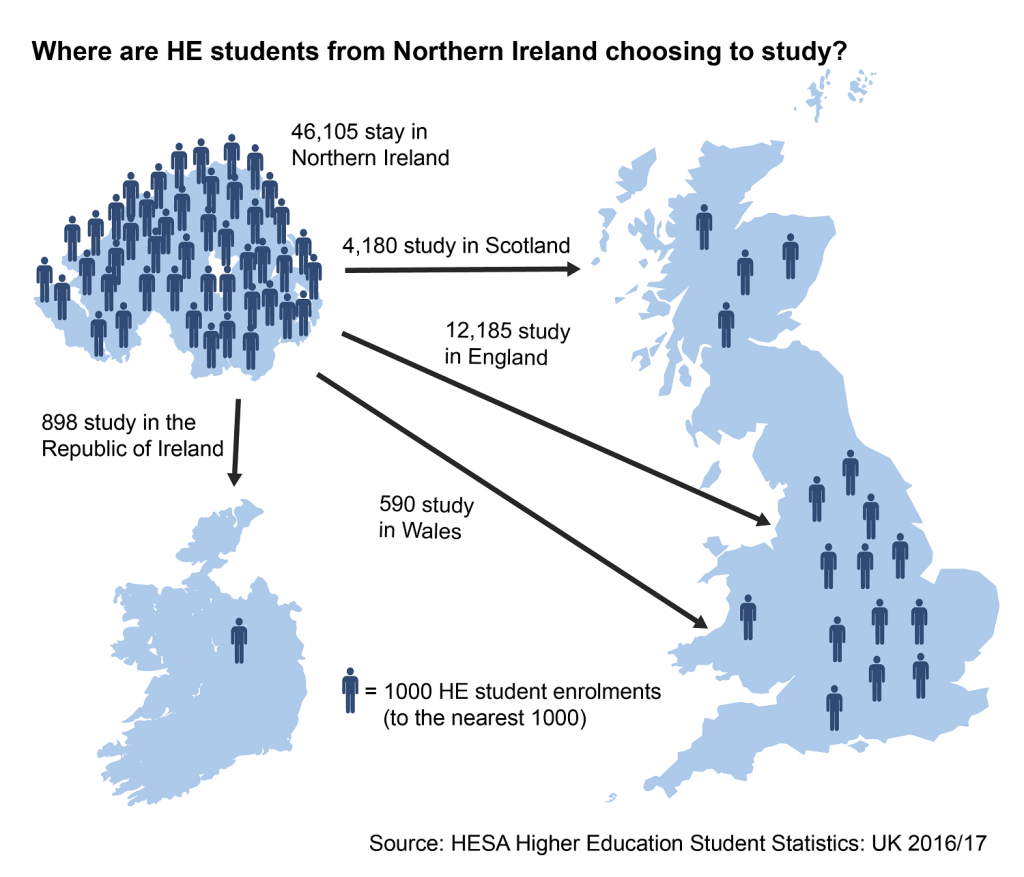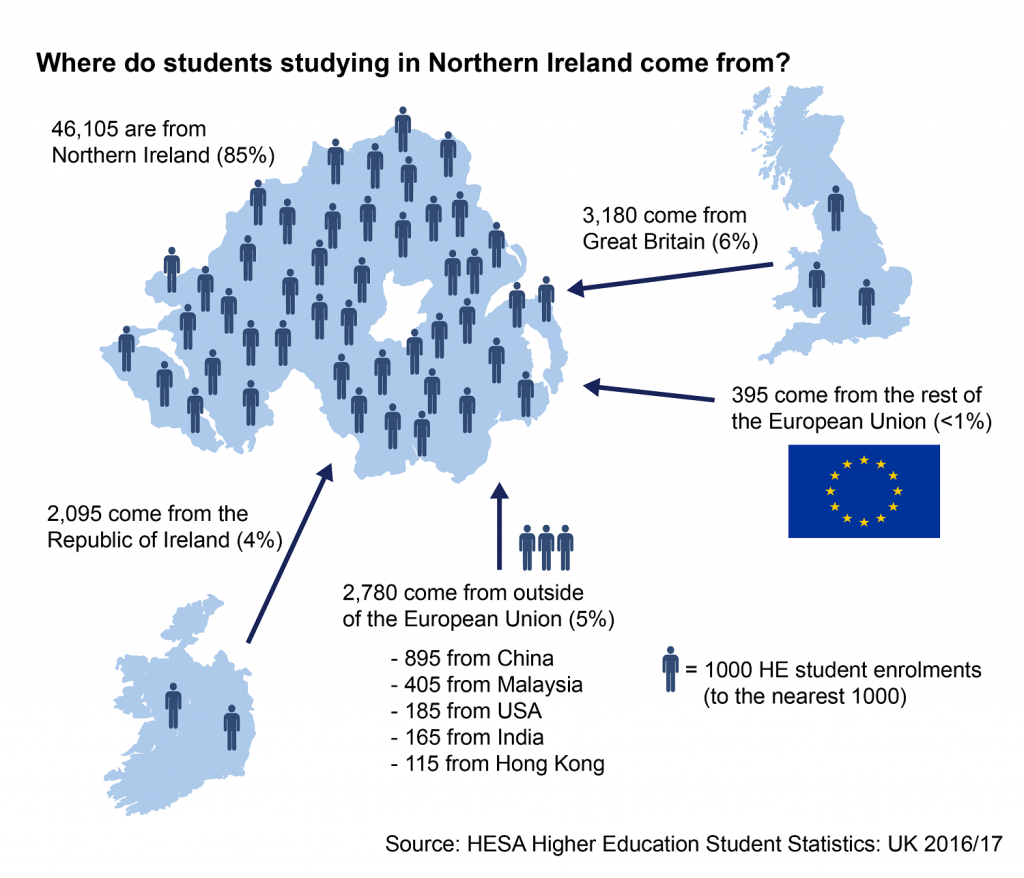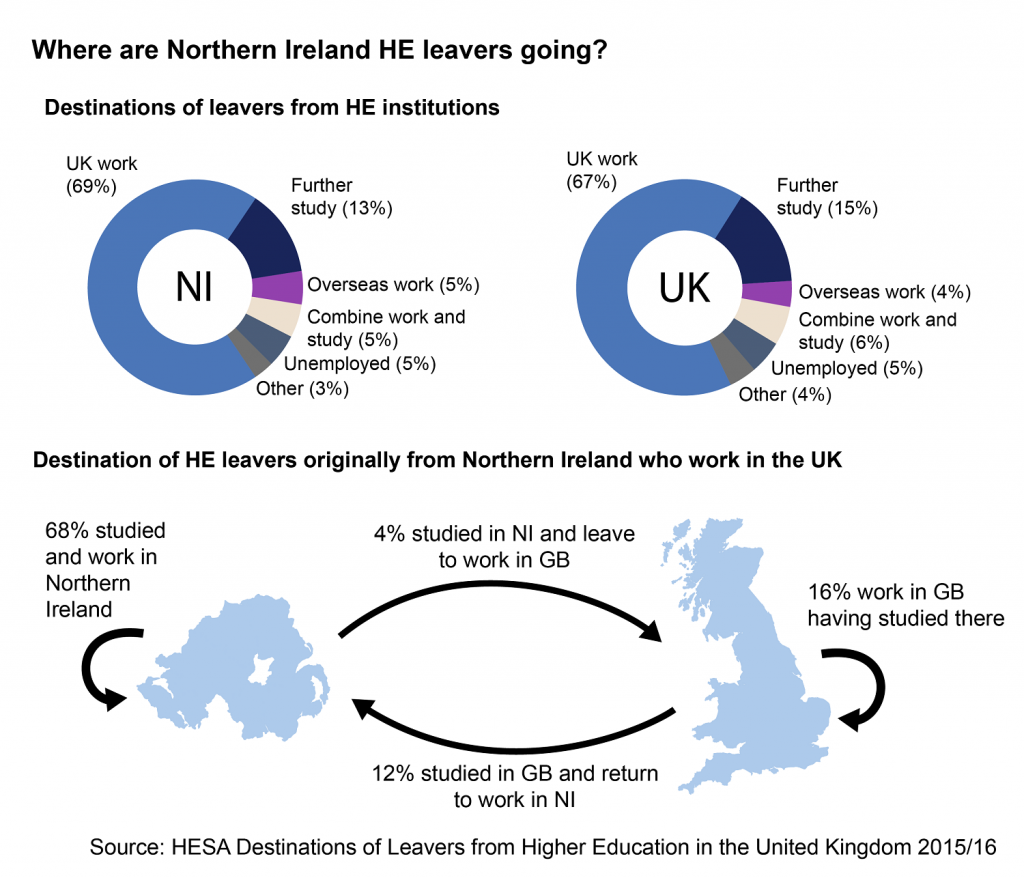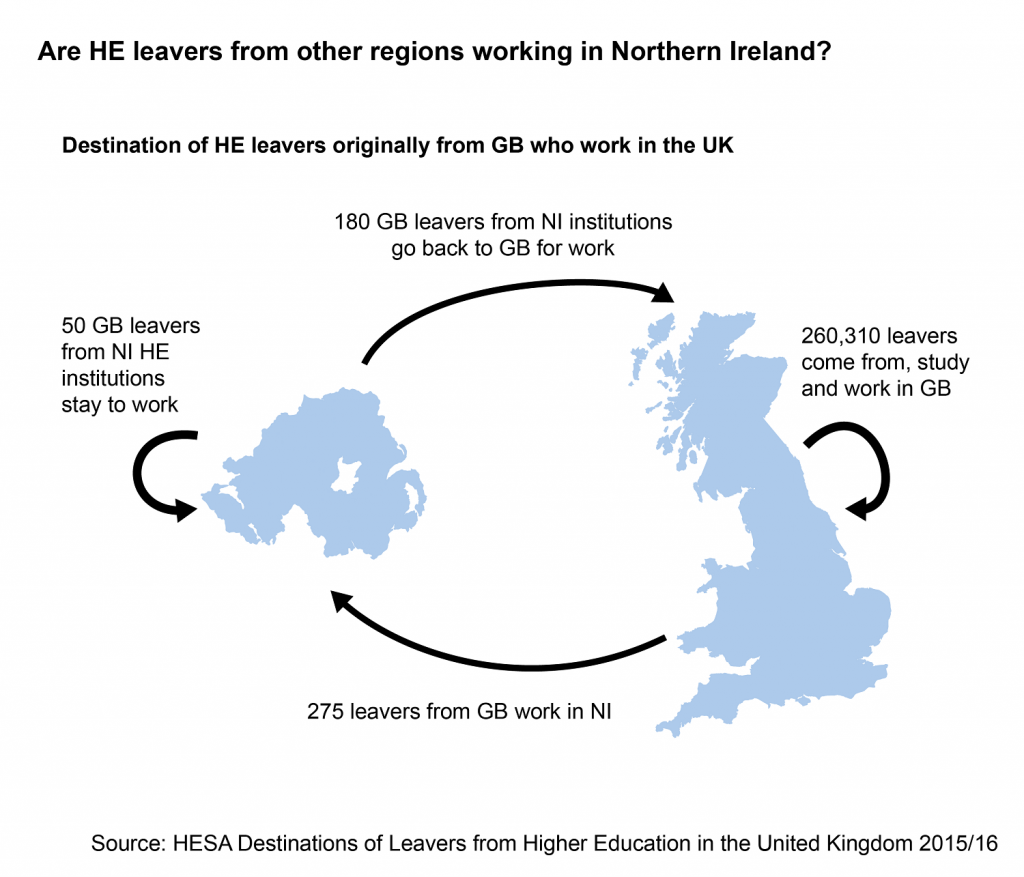
Higher Education (HE) students everywhere are turning their attention towards exams. Many not only face their final exams, but also the decision over where they go next. At the same time, many school pupils will be hoping their exams will enable them to attend the HE institutions (HEIs) of their choice. These decisions are not just important on the individual level: where students come from and where they go to enter the workforce are important to the skills makeup of a country’s regional economy. In this post, relying on data from the Higher Education Statistics Agency, we look at how Northern Ireland (NI) is performing in attracting HE students to study here and whether Northern Ireland HE graduates remain in NI, bringing their skills to the local economy.
The specific reports utilised in this analysis are the Destinations of Leavers from Higher Education in the United Kingdom for the academic year 2015/16 and Higher Education Student Statistics: UK 2016/17. These cover all publicly funded UK Higher Education providers.
Where are HE students from Northern Ireland choosing to study?
In 2016/17, 63,070 individuals from NI enrolled in HEIs in the United Kingdom – 3.4% of the total UK student population. 46,105, or 73%, of those were studying in Northern Ireland. This is low compared to the other UK nations. 93% of UK HE students study in their home nation; only Wales ranks lower than Northern Ireland, with 69% of its students staying.
Of those who leave Northern Ireland, most go to English HEIs – 12,185 or 19%. 4,180 (7%) study in Scotland and 590 (1%) study in Wales. Students from North Down and Ards (34%), Derry and Strabane (32%) and Causeway Coast and Glens (31%) are the most likely to leave to study in Great Britain. By contrast, students from Mid-Ulster (18%), Belfast (24%) and Armagh, Banbridge and Craigavon (25%) are the most likely to stay in Northern Ireland. Within England, the North West region has the most Northern Ireland resident students, with 4,915.
These data include only students who study in the UK, not those who go elsewhere, in particular to the Republic of Ireland. According to data from the Higher Education Authority in the Republic of Ireland, a relatively small cohort from NI go to ROI – only 898 in 2016/17. Potential explanations for small numbers choosing to study across the border may reflect the added difficulty of applying to study in a separate HE system.

Where do students studying in Northern Ireland come from?
54,570 students study in HEIs in Northern Ireland; 46,105 (84%) of them come from Northern Ireland. A further 3,180 (6%) come from Great Britain – 2,805 from England, 260 from Scotland and 115 from Wales. The remainder are international students (including those from the Republic of Ireland) – 5,270, 10% of the overall total.
International students are split roughly evenly between European Union and non-EU students, with 2,490 (5%) from the EU and 2,780 (5%) from outside the EU. Of EU students, the vast majority come from the Republic of Ireland – a total of 2,095 students, 84% of all EU students at Northern Ireland HE institutions. That leaves only 395 EU students from member nations other than the Republic of Ireland – less than 1% of students in Northern Ireland. For comparison, EU students make up 7% of UK student enrolments, but only 8% of EU students in the UK as a whole are from the Republic of Ireland.
2,780 non-EU international students study in Northern Ireland. The most common nations of origin are China (895), Malaysia (405), USA (185), India (165) and Hong Kong (115).

Where are Northern Ireland HE leavers going?
Following full-time, first degree courses, the majority of UK and EU domiciled students leaving Northern Ireland HEIs go into employment in the UK (69%, 4430 in 2015/16). The next most popular option is further study (13%), with small numbers working overseas (5%) or combining work and study (5%). 5% remain unemployed, whilst 3% are categorised as “other”. 5% unemployed is exactly the same as the other UK nations, except for England where 6% were unemployed.
Next we will look at these students who go into work in the UK and identify where they choose to work.
In the 2015/16 study, there were 9,575 HE leavers originally from Northern Ireland who went into work in the UK. 79% of them would go on to work in the region, regardless of where they studied. This is one of the highest proportions – only behind Scotland (89%) and London (81%). It is driven by a particularly large number of students who never leave the region during their studies or work – 6,485 in 2015/16. This amounts to 68% of all HE students originally from Northern Ireland. The apparent trend for these students is to choose to stay here to work.
Another apparent trend is the lower return rate of the students originally from Northern Ireland leaving to go to university. 2,690 students from Northern Ireland left HEIs elsewhere in the UK, but only 1,115 (41%) return to work.

Are HE leavers from other regions working in Northern Ireland?
In short, no. Of leavers who started work in the UK, only 325 started work in Northern Ireland and were not originally from the region. One might expect that the majority of these would have studied in Northern Ireland and chosen to stay, but that is not the case. Only 230 of all the leavers were from Great Britain and studied in Northern Ireland, and only 50 stayed to work in the region (22%). 275 studied in other regions before starting work in Northern Ireland. The bottom line, though, is that very few graduates who were not from Northern Ireland originally choose to work in the region – whether they studied here or not.

This raises some interesting issues about how to better attract and retain graduates, especially given their projected future significance in terms of the Northern Ireland economy. According to the Skills Barometer 2017 report, Northern Ireland is going to face a significant deficit in high-level qualifications in the workforce over the coming decade and will need to fill those needs in order to maximise economic growth. Whilst overall young people originally from Northern Ireland tend to stay within the region, it remains a pressing question as to how Northern Ireland can continue to attract more graduates to work from both within and outside its borders.

